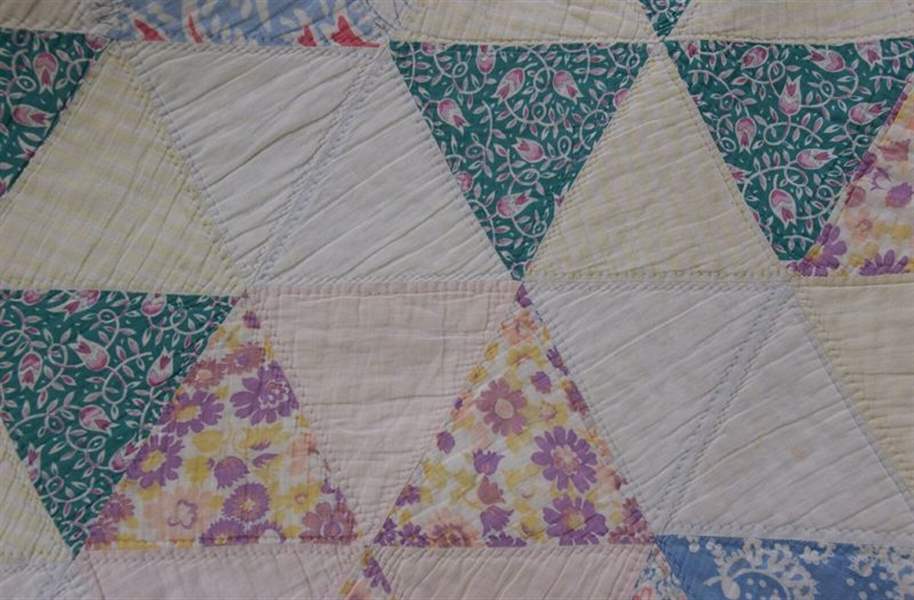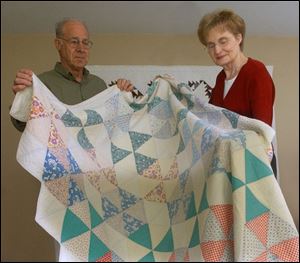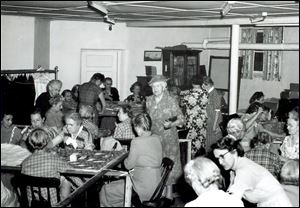
Worn cloth tells warm tale of close community
4/24/2005
Detail from one of the quilts that will be part of the Sauder Village annual quilt fair that runs Tuesday through Sunday.
KING / BLADE

Howard and Carolyn Snyder hold up one of the 18 quilts in their Pettisville home.
Sixty years ago, Mennonite families in northwest Ohio and across North America heard a horror story that led them to lift heirloom quilts out of their hope chests and ship them to strangers half a world away.
Thousands of fellow Mennonites in Russia, who had once been wealthy farmers, were now starving refugees, straggling across Europe - mostly on foot - into Holland. They were arriving as groups of women and young children; most of the men and teenagers had been exiled to Siberia by Russian Communist authorities - or shot or burned alive - for so-called crimes as small as possessing a Bible.
Church sewing circles in local Mennonite communities such as Archbold, Bluffton, Pandora, and Elida responded by quickly knotting comforters to send to the refugees in Holland as well as much fancier quilts already made for their own families.
And when their offerings arrived at the home of An Keuning-Tichelaar in early January, 1946, she was disappointed.
The young minister's wife had asked for mattresses and heavy blankets - not cotton quilts - for the family of four refugees she and her husband had volunteered to house. They had little for the refugees to sleep on. Nor did their neighbors have much to lend.

Detail from one of the quilts that will be part of the Sauder Village annual quilt fair that runs Tuesday through Sunday.
The community had used almost every extra piece of bedding it had in the years that they hid Jews from the Nazis. At the Keuning-Tichelaar's safe house, those mattresses and blankets had become so vermin-infested from dozens of travelers that when the last one left, Mrs. Keuning-Tichelaar burned all the bedding.
Then, only four months later, Russian refugees started arriving in the village - completely unexpected.
Mennonite relief workers in Holland told Mrs. Keuning-Tichelaar they didn't have mattresses, but they had lots of quilts from the United States and Canada. Donated quilts were so plentiful that Mrs. Keuning-Tichelaar was urged to take some 50, so that the refugees could sleep on layer upon layer of handmade quilts, with plenty left for covers.

Women from First Mennonite Church in Bluffton quilt for their denomination s relief efforts in this 1940s-era photo, when the focus was on refugees in Europe. Scenes such as this were typical in church basements and in Mennonite homes.
There were quilts and comforters to give many of the refugees when they left Holland on their way to Canada, if they could find a sponsor there, or to Paraguay in South America, one of the only countries that would take them without a sponsor.
There were enough quilts and comforters that about 20 were left at the Keuning-Tichelaar home after the last refugees had moved on.
Sixty years later, those bed coverings are faded, worn, patched, and expected to be one of the most stunning exhibits at the Sauder Village annual quilt fair which opens Tuesday and runs through Sunday just north of Archbold in Fulton County.
"The quilts in themselves are not going to be the beauty of this show," said Carolyn Snyder, former quilt shop manager at Sauder Village. "It's the story that's so fascinating."
Mrs. Snyder and her husband, Howard, retirees from Pettisville in southwestern Fulton County, found the story so important that they volunteered to criss-cross the United States and Canada in a motor home for at least a year, taking 18 of the quilts and a sizeable display about them to events in Mennonite communities.
It's the first time that the Mennonite relief organization, called Mennonite Central Committee, has put such a show on the road. And even though the Snyders are donating their time, expenses are estimated at $250,000 for a three-year tour that began this month in Pennsylvania.
From the opening day in Lancaster County, Pennsylvania, the exhibit's impact appeared to organizers to be well worth the cost.
"I just want you to know I was taught to quilt at age 11 and did it out of a sense of duty," a conservative, middle-aged Mennonite woman told Mrs. Keuning-Tichelaar, who had traveled from the Netherlands for the exhibit's opening, according to Lois Flickinger, a coordinator of the quilt tour. "But now I want you to know I'll spend the rest of my life quilting with a sense of purpose."
Part of the reason for the exhibit is to thank the comforter and quilt makers, who have been donating their handiwork to refugees for generations.
Mennonite Central Committee typically distributes 70,000 to 80,000 handmade comforters and quilts a year in disaster zones worldwide. Some years, such as last year when Iran was devastated by earthquakes, 140,000 comforters and quilts are sent.
And that doesn't count about 4,000 fancy quilts - which take far longer to design, piece, and stitch - that Mennonites make for benefits called relief sales, which sell quilts to raise money for disaster aid.
Those numbers mean that an average of about one out of every six Mennonites in North America is donating a handmade quilt or comforter every year: The Mennonite population in the United States and Canada is estimated at less than 500,000.
Ohio, which has the second-largest population of Amish and Mennonites in the world, is among the top five U.S. states and Canadian provinces for comforter and quilt donations, said Dave Worth, resource network director with Mennonite Central Committee at its headquarters in Akron, Pa.
Making even the simplest comforter takes about eight hours. More intricate designs and quilts take far more time.
Mennonite Central Committee doesn't ask for handmade comforters and quilts because they make economic sense. It would be easier, of course, to buy blankets in bulk for $5 to $10 each.
But handmade bedding sends a message of love to refugees that a warm blanket made in a factory just doesn't carry, Mr. Worth said.
The comforters and quilts the Mennonites distribute are so obviously homemade that refugees around the world understand that: "Here is something that came from a real live human being. You have not been abandoned. You have not been forgotten," he said.
In Croatia, Mr. Worth heard a Mennonite aid worker asking recipients to look at the different shapes and colors of patches in their comforters.
"That's kind of like our country," he recalled the aid worker saying about the United States and Canada. "We're all different . . . . sewed together with God's love."
It's not known which Mennonite communities made the 20 quilts and comforters left in the Keuning-Tichelaar home in Holland. Nor do exhibit organizers expect to learn that in the tour.
Several have been so extensively repaired that they might be hard to recognize even to the people who pieced them. And after 60 years, Ms. Flickinger said she suspects that the women who made those quilts are all dead.
What she has more hope of finding, especially when the exhibit goes to Canada, are former refugees who remember passing through the Keuning-Tichelaar home and sleeping under those quilts as children.
The story of the quilts came to light when a bookstore owner in the Netherlands, who grew up in a Mennonite family in Minnesota, stayed at the Keuning-Tichelaar home in the 1980s and saw the quilts.
This month a book about the quilts called Passing on the Comfort by the bookstore owner, Lynn Kaplanian-Buller, and Mrs. Keuning-Tichelaar, was published by Good Books. Preparation for that book spawned the quilt tour.
At Sauder Village this week, the quilts will be in a display with 460 other quilts. The historic village's quilt fair has drawn between 5,500 and 6,700 people a year in the last three years. This year, for the fair's 29th year, a record 460 quilts are expected.
Bed quilts, quilted wall hangings, and miniature quilts, ranging in styles from traditional appliqued and pieced to contemporary art designs will be exhibited in the competitive show. Almost all the quilts will be in far better condition than those in the Mennonite Central Committee exhibit.
But their story of courage and compassion will be hard to beat.
Mrs. Keuning-Tichelaar was a newlywed in her 20s, suffering from a severe, undiagnosed back injury, when she and her husband opened their home to waves of refugees - first Jews then Russian Mennonites.
Food was scarce, disease was rampant, it was hard to know who to trust, and great risks were taken over and over again. Ms. Flickinger said she knows of a Pennsylvania woman who makes more than 100 child-size comforters a year because a comforter was given to her when she was a child in Europe in the 1940s.
"To her that was a sign somebody cared whether she lived or died," Ms. Flickinger said.
Contact Jane Schmucker at:
jschmucker@theblade.com
or 419-337-7780.